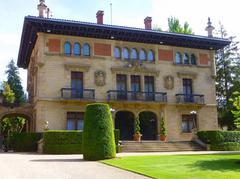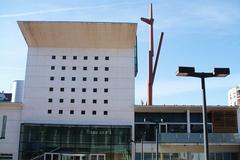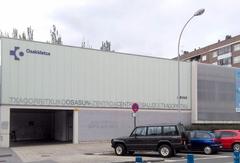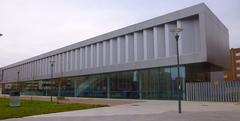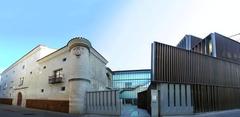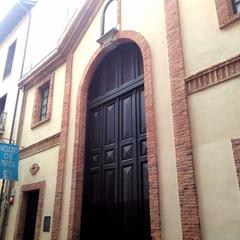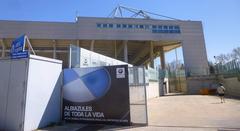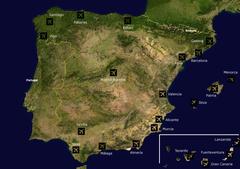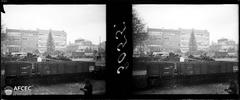
Green Belt of Vitoria-Gasteiz: Visiting Hours, Tickets, and Travel Guide
Date: 04/07/2025
Introduction
The Green Belt of Vitoria-Gasteiz is a landmark achievement in urban ecological restoration and sustainable city planning. Encircling the Basque capital, this vast peri-urban corridor interconnects parks, wetlands, forests, and meadows, creating a harmonious interface between nature and city life. Originally conceived in the late 20th century to address environmental degradation and urban sprawl, the Green Belt has transformed former gravel pits and neglected land into 30 kilometers of accessible green space for biodiversity, recreation, and community wellbeing. Visitors are invited to explore its diverse habitats, enjoy free outdoor access, participate in guided tours, and experience the city’s commitment to sustainability that earned it the 2012 European Green Capital award. This guide covers the Green Belt’s history, ecological significance, visiting hours, ticketing, accessibility, key attractions, and practical tips for planning your visit (Vitoria-Gasteiz Green Belt - History; POCACITO Urban Green Belt VG PDF; Europarc Case Study).
Table of Contents
- Historical Development and Ecological Restoration
- Visiting Information: Hours, Tickets, Accessibility
- Key Parks and Attractions
- Guided Tours, Activities, and Events
- Frequently Asked Questions (FAQs)
- Visitor Tips and Recommendations
- Nearby Attractions and Further Exploration
- Sources and Further Reading
Historical Development and Ecological Restoration
From Degradation to Green Oasis
By the 1980s, Vitoria-Gasteiz’s outskirts were marred by abandoned gravel pits, dumps, drained wetlands, and fragmented forests. The city’s rapid industrial growth and expansion had led to significant habitat loss and a disconnect between urban and rural life (Wikipedia: Green Belt of Vitoria-Gasteiz). In the early 1990s, the Green Belt concept was launched by the Centro de Estudios Ambientales (CEA) with strong municipal and EU support, aiming to restore degraded sites and reconnect the city to its natural surroundings (POCACITO Urban Green Belt VG PDF).
Design and Implementation
The Green Belt was envisioned as a network of interconnected parks and ecological corridors, each restoring native habitats and providing accessible recreation for residents and visitors alike. Key milestones included hydrological restoration (notably in the Salburua wetlands), the revitalization of ancient oak forests (Armentia), the creation of cycling and walking paths, and the introduction of Spain’s first free bicycle-lending service in 2004. By 2011, over €34 million had been invested in the project (POCACITO Urban Green Belt VG PDF).
Recognition and Impact
Today, the Green Belt spans over 645 hectares (with expansion plans), comprising six major parks and numerous ecological corridors. It has received international awards for best practices in urban sustainability, and has played a key role in Vitoria-Gasteiz’s selection as European Green Capital (Vitoria-Gasteiz Green Belt - History). The project has fostered increased walking and cycling, improved air quality, and enhanced social inclusion by ensuring that all residents live within 300 meters of green space (Europarc Case Study).
Visiting Information: Hours, Tickets, Accessibility
Opening Hours
- Outdoor Parks and Trails: Open year-round, generally from dawn to dusk.
- Ataria Interpretation Center (Salburua): Open daily, 10:00 AM – 6:00 PM; extended hours in summer.
- Olarizu Botanical Garden: 9:00 AM – 8:00 PM in summer; shorter hours in winter.
Tickets
- General Entry: Free access to all parks and outdoor areas.
- Ataria Interpretation Center: Free admission; some special exhibitions or activities may require booking and a small fee.
Accessibility
- Paths: Well-maintained, flat, and suitable for wheelchairs and strollers, especially in Salburua and Olarizu.
- Transport: Reachable by foot, bicycle (with bidegorri cycling lanes), and public transport. Parking is available at major park entrances.
- Bike Rentals: Available in the city center and near main park entrances.
Key Parks and Attractions
Salburua Wetlands
A centerpiece of the Green Belt, Salburua is a restored wetland and Ramsar site supporting over 200 bird species, including migratory and endangered birds. The Ataria Interpretation Center features interactive ecology exhibits and panoramic observation decks.
Olarizu Park and Botanical Garden
South of the city, Olarizu offers wildflower meadows, a panoramic hill, and a large botanical garden with native and exotic plants. It is ideal for picnics, walking, and environmental education.
Armentia Forest
This ancient oak woodland on the western edge preserves biodiversity and cultural heritage, including the Basilica of San Prudencio. Its shaded trails are perfect for walks and family outings.
Zabalgana, Zadorra, and Errekaleor Parks
- Zabalgana: Restored wetlands, sports facilities, and community gardens.
- Zadorra: Linear park along the river, with riparian forests and cycling paths.
- Errekaleor: Community-managed green space with meadows and playgrounds.
Other Features
- Old Basque-Navarre Railway Line Greenway: Ecological corridor for walking and cycling.
- Interpretive Centers: Information panels and facilities throughout the network.
Guided Tours, Activities, and Events
- Guided Tours: Offered seasonally by the CEA and local organizations, focusing on ecology, history, and birdwatching. English tours available on request.
- Workshops & Educational Programs: Especially at Ataria and Olarizu; booking recommended for group activities.
- Events: Bird migration festivals, nature walks, planting days, and family activities throughout the year.
- Cycling: Complete the 30 km loop or enjoy shorter, family-friendly sections.
Frequently Asked Questions (FAQs)
Q: Do I need a ticket to visit the Green Belt parks?
A: No, entry is free to all outdoor areas. Special tours or workshops may have a fee.
Q: What are the Green Belt opening hours?
A: Parks are open from dawn to dusk year-round. Visitor centers (e.g., Ataria) are typically open 10:00 AM–6:00 PM.
Q: Is the Green Belt accessible for people with reduced mobility?
A: Yes, most main paths and facilities are wheelchair- and stroller-friendly.
Q: Can I rent a bike?
A: Yes, bike rentals are available in the city center and near park entrances.
Q: Are pets allowed?
A: Yes, pets are welcome but must be kept on a leash.
Q: Are there guided tours in English?
A: Most tours are in Spanish and Basque; English tours can be arranged on request.
Visitor Tips and Recommendations
- Best Time to Visit: Spring and autumn for birdwatching and mild weather; summer for long days and outdoor events.
- What to Bring: Comfortable walking shoes, water, sun protection, binoculars, and a camera.
- Picnics: Designated areas in all parks; barbecue facilities available in some locations.
- Respect Nature: Stay on marked trails and follow signage.
Nearby Attractions and Further Exploration
- Vitoria-Gasteiz Old Town: Medieval streets, Santa María Cathedral, and local restaurants.
- Artium Museum of Contemporary Art: Modern exhibitions close to the Green Belt.
- Cultural Events: Seasonal festivals both in the city and within the parks.
Sources and Further Reading
- Vitoria-Gasteiz Green Belt - History
- POCACITO Urban Green Belt VG PDF
- Europarc Case Study: Vitoria-Gasteiz Green Belt Actions for Conservation and Biodiversity
- Wikipedia: Green Belt of Vitoria-Gasteiz
- Vitoria-Gasteiz City Council
- All About Rosalilla – Best Things to Do in Vitoria-Gasteiz
- Audiala Guide: Ataria
- Touristear – Best Things to Do in Vitoria-Gasteiz
- Kora Green City – Top Things to Do in Vitoria-Gasteiz
- Winalist – Vitoria-Gasteiz Things to Do
- The Go Guy – Best Things to Do in Vitoria-Gasteiz

